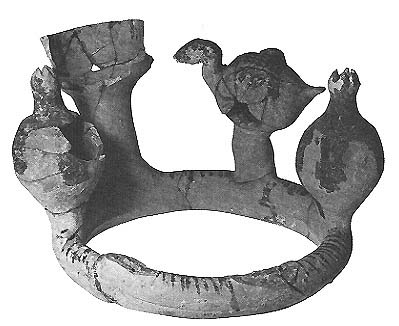Kibbutz Sasa Kernos
A kernos (plural- kernoi) is a hollow pottery ring usually about 12 inches in diameter with various hollow pottery objects sitting on the ring and attached to it.
The Kibbutz Sasa kernos originally had six objects perched on the ring, of which four survive. Although other kernoi—or, more accurately, pieces of kernoi—have been found at Gezer, Ashdod, Beth Shean and elsewhere, the Kibbutz Sasa kernos is one of the most nearly complete ever excavated in Israel. Only the Megiddo kernos is more nearly complete, with seven of its eight original objects remaining.
The hollow objects on the Kibbutz Sasa kernos are a bird, a chalice and two pomegranates. Other kernoi have had various vessels, birds and animal heads.
The Kibbutz Sasa kernos is painted in black and red with geometric motifs, which suggests an Aegean cultural origin for the object and its design.
According to Prof. Trude Dothan in her forthcoming book on the Philistinesa, kernoi probably originated in Cyprus. The kernoi found in Palestine are generally associated with the Philistines and exemplify the link between Mycenean and Philistine culture.
Kernoi are “unmistakably cultic”, says Prof. Dothan. Most likely, a liquid, probably wine, was poured into the ring through one of the hollow vessels which surmount it. Perhaps some incantation or prayer was said, the liquid was circulated through the hollow ring and then poured out one of the other objects on the ring. On the Kibbutz Sasa kernos, the liquid was probably poured in through the bottomless chalice which sits on the ring. The chalice is the largest of the objects on the ring and seems made for this purpose. (The small holes where the two missing objects sat on the ring indicate they were not as large as the chalice.)
The Kibbutz Sasa kernos was found during an emergency excavation when the Kibbutz—located in Upper Galilee just a few miles from the Lebanese border—discovered ancient remains as it was preparing ground for construction of a new school. The Antiquities Department immediately sent Hebrew University archaeology student Brocha Guz to direct the excavation of the immediate area, in the course of which the kernos was found. Thereafter Dan Bahat, Antiquities Department archaeologist, completed the excavation, but only typical Israelite storage jars were found. Based on these jars, Bahat dates the kernos to the 12th or 11th centuries B.C.
But what is a kernos doing on the floor of a house with Israelite storage jars? Were the Philistines or other Sea Peoples living here? Or were early Israelites using a kernos? Or, is there perhaps some other explanation? Only further study and excavation will provide the answers.
“The Kibbutz Sasa Kernos,” BAR 2-02, Jun 1976.
